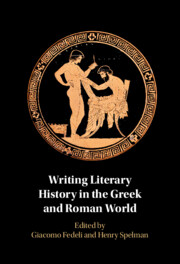Book contents
- Writing Literary History in the Greek and Roman World
- Writing Literary History in the Greek and Roman World
- Copyright page
- Contents
- Contributors
- Introduction
- Part I Between Literature and Scholarship
- Chapter 1 Writing the Beginnings of Greek Literary History
- Chapter 2 Contrasting Pairs and Twin Graves
- Chapter 3 Ancient Histories of Satire(s)
- Chapter 4 Cicero as a Literary Historian
- Chapter 5 Varro and the Spirits of Rome’s Literary Past
- Part II Lives and Afterlives
- Part III Narratives of Change
- Epilogue
- Afterword
- Bibliography
- Index Locorum
- Index of Subjects
Chapter 2 - Contrasting Pairs and Twin Graves
Companion Epigrams and the History of Technai
from Part I - Between Literature and Scholarship
Published online by Cambridge University Press: 07 June 2024
- Writing Literary History in the Greek and Roman World
- Writing Literary History in the Greek and Roman World
- Copyright page
- Contents
- Contributors
- Introduction
- Part I Between Literature and Scholarship
- Chapter 1 Writing the Beginnings of Greek Literary History
- Chapter 2 Contrasting Pairs and Twin Graves
- Chapter 3 Ancient Histories of Satire(s)
- Chapter 4 Cicero as a Literary Historian
- Chapter 5 Varro and the Spirits of Rome’s Literary Past
- Part II Lives and Afterlives
- Part III Narratives of Change
- Epilogue
- Afterword
- Bibliography
- Index Locorum
- Index of Subjects
Summary
This chapter shows how epigrams contributed to the formation and dissemination of literary criticism and theories of style, while also expressing ideas about literary history and the development of a given literary genre or τέχνη. These epigrams, which allowed their author to express ideas on literary tradition and style, were often written as pseudo-epitaphs for poets of the past. The use of companion pieces could also allow epigrammatists, such as Posidippus of Pella, Asclepiades of Samos, Dioscorides of Nicopolis and Antipater of Sidon, to comment on pairs of artists or poets who represented different and often opposing aesthetics. Posidippus’ and Dioscorides’ epigrams are of peculiar interest, since they seem to allude to lost treatises that used recurring frameworks to write the history of a given τέχνη, for example one of the visual arts or a literary genre. The ideas initially expressed in these prose treatises appear to have been reworked, in a very creative manner, by epigrammatists who were eager to formulate their own ideas about poetry.
Keywords
- Type
- Chapter
- Information
- Writing Literary History in the Greek and Roman World , pp. 40 - 61Publisher: Cambridge University PressPrint publication year: 2024

